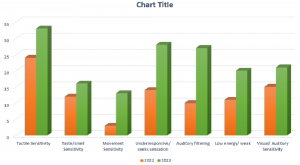Efficacy of Online Occupational Therapy in Sensory Processing Disorder : A case study
Efficacy of Online Occupational Therapy in Sensory Processing Disorder : A case study
Autism spectrum disorder (ASD) is a developmental disability caused by differences in the brain. People with ASD often have problems with social communication and interaction, and restricted or repetitive behaviours or interests. People with ASD may also have different ways of learning, moving, or paying attention. About 1 in 36 children has been identified with autism spectrum disorder (ASD). About 1 in 6 (17%) children aged 3–17 years were diagnosed with a developmental disability – these include autism, attention-deficit/hyperactivity disorder, blindness, and cerebral palsy, among others.
Current study indicates that accompanying sensory processing problems are reported in more than 80% children with autism. Hyper or hypo reactivity to sensory inputs is now a diagnostic criterion for ASD. According to the theoretical basis of sensory integration – vestibular, proprioceptive, tactile, auditory and visual systems as well as olfaction & gustation have a significant importance.
Case Study: Efficancy of Online Occupational Therapy in Sensory Processing Disorder
Client Information:
- Age: 5.5 years old
- Diagnosis: Autism & sensory processing disorder
- Assessment Tool: Sensory Profile
- Assessment Period: Aug’2022 and Jul’2023
Sensory Profile Results:
The Sensory Profile is a caregiver questionnaire used to measure a child’s responses to sensory events in everyday life. It assesses various sensory processing patterns and provides scores indicating the extent of sensitivity or responsiveness in different sensory domains.
The GRAPH presents data on different sensory sensitivities and their corresponding percentages for the years 2022 and 2023, along with the total values. In 2022, Tactile Sensitivity accounted for 24 (69%) of the total, Taste/Smell Sensitivity accounted for 12 (60%), Movement Sensitivity accounted for 3 (20%), Under-responsive/Seeks Sensation accounted for 14 (40%), Auditory Filtering accounted for 10 (33%), Low Energy/Weak accounted for 11 (37%), and Visual/Auditory Sensitivity accounted for 15 (60%). The total value in 2022 was 89 (47%). Moving to 2023, there was significant growth in all categories, resulting in a total value of 154 (81%), indicating a substantial increase in sensory sensitivities overall
Analysis and Intervention Plan:
-
Tactile Sensitivity:
- Increase exposure to tactile stimuli through activities such as sand play, finger painting, and textured materials.
- Gradually introduce different textures and sensations to desensitize the child’s tactile sensitivity.
- Use deep pressure and proprioceptive input during activities to provide a calming effect.
-
Taste/Smell Sensitivity:
- Offer a variety of foods with different tastes and textures to encourage exploration.
- Gradually introduce new flavours and smells, starting with preferred options.
- Establish a predictable routine during mealtimes to reduce anxiety and promote a positive eating experience.
-
Movement Sensitivity:
- Implement activities that provide controlled movement experiences, such as swinging or rocking.
- Gradually expose the child to movement sensations through activities like bike riding or trampoline jumping.
- Encourage motor planning skills through obstacle courses or structured games.
-
Under-responsive/Seeks Sensation:
- Create a sensory-rich environment to increase the child’s engagement and response to sensory input.
- Incorporate sensory breaks throughout the day to provide sensory stimulation and promote attention and alertness.
- Use activities that provide intense sensory input, such as jumping on a crash pad or using a therapy ball.
-
Auditory Filtering:
- Implement a quiet and structured environment to minimize auditory distractions.
- Use visual supports, such as visual schedules and cues, to enhance understanding and reduce reliance on auditory input.
- Gradually introduce auditory stimuli and teach coping strategies for handling auditory overload.
-
Low Energy/Weak:
- Incorporate activities that promote strengthening and endurance, such as climbing, jumping, or animal walks.
- Use motivating and engaging activities to increase the child’s participation and energy level.
- Provide frequent breaks and pacing strategies to prevent fatigue during tasks.
-
Visual/Auditory Sensitivity:
- Create a visually organized and calm environment to reduce sensory overload.
- Use ear defenders or noise-cancelling headphones to minimize auditory sensitivity.
- Gradually expose the child to visually stimulating materials and provide support to manage any anxiety or aversion.
Conclusion:
- Occupational therapy interventions for children with autism vary based on their individual needs. The primary goal of occupational therapy is to improve the quality of life and enable individuals to participate in daily activities. Sensory integration therapy is often incorporated into holistic and client-centered treatment plans. By utilizing effective strategies and techniques, occupational therapy can provide opportunities for individuals with autism to develop a wide range of skills.
- This case study highlights the importance of sensory processing in individuals with autism and the role of occupational therapy in addressing sensory sensitivities. By creating a sensory-friendly environment, gradually exposing the child to different sensory experiences, and providing appropriate supports and strategies, occupational therapy aims to enhance sensory integration skills and overall functioning. Regular reassessment and modifications to the intervention plan based on the child’s progress and changing needs are crucial for optimal outcomes.
- Overall, occupational therapy plays a significant role in supporting individuals with autism by addressing their sensory processing difficulties and promoting their engagement and participation in meaningful activities. By implementing evidence-based practices and individualizing interventions, occupational therapists can assist children with autism in developing essential skills for everyday life.


Leave a Comment
(0 Comments)